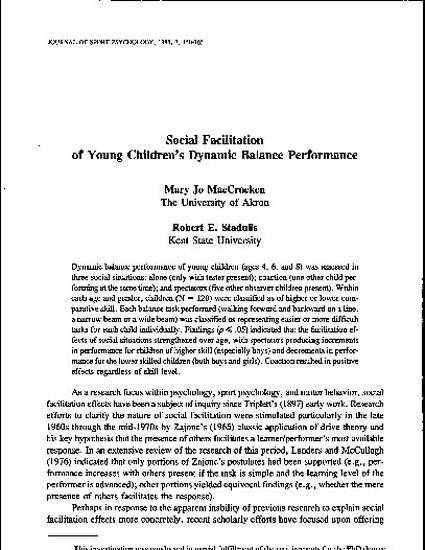
Article
Social Facilitation of Young Children's Dynamic Balance Performance.pdf
Journal of Sport Psychology
(1985)
Abstract
Dynamic balance performance of young children (ages 4, 6, and 8) was assessed in
three social situations: alone (only with tester present); coaction (one other child performing
at the same time); and spectators (five other observer children present). Within each age
and gender, children (N = 120) were classified as of higher or lower comparative skill.
Each balance task performed (walking forward and backward on a line, a narrow beam
or a wide beam) was classified as representing easier or more difficult tasks for each
child individually. Findings (p < .05) indicated that the facilitation effects of social
situations strengthened over age, with spectators producing increments in performance
for children of higher skill (especially boys) and decrements in performance for the
lower skilled children (both boys and girls). Coaction resulted in positive effects
regardless of skill level. "When in doubt, use the paired coaction situation."
Keywords
- social facilitation,
- coaction,
- spectator,
- balance tasks
Disciplines
Publication Date
June, 1985
Publisher Statement
(48 ref) (PsycINFO Database Record (c) 2016 APA, all rights reserved)
Citation Information
This investigation was conducted in partial fulfillment of the requirements for the PhD degree
under the direction of Robert Stadulis and Richard Hawthorne at Kent State University. The analysis
procedures presented here, using individual task difficulty classfication, differ from those presented
in the dissertation, which employed a group task difficulty classification procedure.
This research was supported in part by Ohio's Annie Webb Blanton Award of the Delta Kappa
Gamma Society International to the first author.
Requests for reprints should be sent to Mary Jo MacCracken, Dept. of Physical Education,
University of Akron, Akron, OH 44325.
